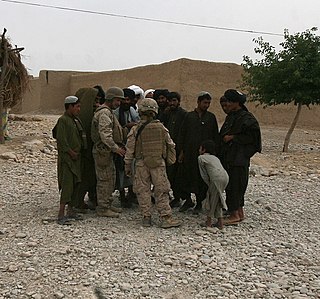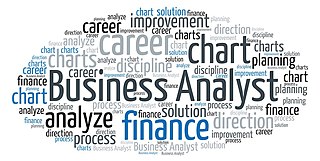
Analysis is the process of breaking a complex topic or substance into smaller parts in order to gain a better understanding of it. The technique has been applied in the study of mathematics and logic since before Aristotle, though analysis as a formal concept is a relatively recent development.

Military intelligence is a military discipline that uses information collection and analysis approaches to provide guidance and direction to assist commanders in their decisions. This aim is achieved by providing an assessment of data from a range of sources, directed towards the commanders' mission requirements or responding to questions as part of operational or campaign planning. To provide an analysis, the commander's information requirements are first identified, which are then incorporated into intelligence collection, analysis, and dissemination.
Marketing research is the systematic gathering, recording, and analysis of qualitative and quantitative data about issues relating to marketing products and services. The goal is to identify and assess how changing elements of the marketing mix impacts customer behavior.
Benchmarking is the practice of comparing business processes and performance metrics to industry bests and best practices from other companies. Dimensions typically measured are quality, time and cost.
Marketing strategy is an organization's promotional efforts to allocate its resources across a wide range of platforms, channels to increase its sales and achieve sustainable competitive advantage within its corresponding market.
Intelligence assessment, or simply intel, is the development of behavior forecasts or recommended courses of action to the leadership of an organisation, based on wide ranges of available overt and covert information (intelligence). Assessments develop in response to leadership declaration requirements to inform decision-making. Assessment may be executed on behalf of a state, military or commercial organisation with ranges of information sources available to each.

A business analyst (BA) is a person who processes, interprets and documents business processes, products, services and software through analysis of data. The role of a business analyst is to ensure business efficiency increases through their knowledge of both IT and business function.
Competitive intelligence (CI) is the process and forward-looking practices used in producing knowledge about the competitive environment to improve organizational performance. It involves the systematic collection and analysis of information from multiple sources, and a coordinated CI program. It is the action of defining, gathering, analyzing, and distributing intelligence about products, customers, competitors, and any aspect of the environment needed to support executives and managers in strategic decision making for an organization.
The intelligence cycle is an idealized model of how intelligence is processed in civilian and military intelligence agencies, and law enforcement organizations. It is a closed path consisting of repeating nodes, which will result in finished intelligence. The stages of the intelligence cycle include the issuance of requirements by decision makers, collection, processing, analysis, and publication of intelligence. The circuit is completed when decision makers provide feedback and revised requirements. The intelligence cycle is also called intelligence process by the U.S. Department of Defense (DoD) and the uniformed services.
Intelligence analysis is the application of individual and collective cognitive methods to weigh data and test hypotheses within a secret socio-cultural context. The descriptions are drawn from what may only be available in the form of deliberately deceptive information; the analyst must correlate the similarities among deceptions and extract a common truth. Although its practice is found in its purest form inside national intelligence agencies, its methods are also applicable in fields such as business intelligence or competitive intelligence.
The following outline is provided as an overview of and topical guide to marketing:
Intelligence-led policing (ILP) is a policing model built around the assessment and management of risk. Intelligence officers serve as guides to operations, rather than operations guiding intelligence.
Intelligence collection management is the process of managing and organizing the collection of intelligence from various sources. The collection department of an intelligence organization may attempt basic validation of what it collects, but is not supposed to analyze its significance. There is debate in U.S. intelligence community on the difference between validation and analysis, where the National Security Agency may try to interpret information when such interpretation is the job of another agency.
Intelligence cycle management refers to the overall activity of guiding the intelligence cycle, which is a set of processes used to provide decision-useful information (intelligence) to leaders. The cycle consists of several processes, including planning and direction, collection, processing and exploitation, analysis and production, and dissemination and integration. The related field of counterintelligence is tasked with impeding the intelligence efforts of others. Intelligence organizations are not infallible but, when properly managed and tasked, can be among the most valuable tools of management and government.
Intelligence Analysis Management is the process of managing and organizing the analytical processing of raw intelligence information. The terms "analysis", "production", and "processing" denote the organization and evaluation of raw information used in a phase informally called "connecting the dots", thus creating an "intelligence mosaic". The information may result in multiple analytic products, each with different security classifications, time scales, and levels of detail. Intelligence analysis goes back to the beginning of history. Sherman Kent is often considered the father of modern intelligence analysis. His writings include a 1947 book, Strategic Intelligence for American World Policy.
Failure in the intelligence cycle or intelligence failure, is the outcome of the inadequacies within the intelligence cycle. The intelligence cycle itself consists of six steps that are constantly in motion. The six steps are: requirements, collection, processing and exploitation, analysis and production, dissemination and consumption, and feedback.
Market intelligence (MI) is gathering and analyzing information relevant to a company's market - trends, competitor and customer monitoring. It is a subtype of competitive intelligence (CI), which is data and information gathered by companies that provide continuous insight into market trends such as competitors' and customers' values and preferences.
Geographic information systems (GIS) play a constantly evolving role in geospatial intelligence (GEOINT) and United States national security. These technologies allow a user to efficiently manage, analyze, and produce geospatial data, to combine GEOINT with other forms of intelligence collection, and to perform highly developed analysis and visual production of geospatial data. Therefore, GIS produces up-to-date and more reliable GEOINT to reduce uncertainty for a decisionmaker. Since GIS programs are Web-enabled, a user can constantly work with a decision maker to solve their GEOINT and national security related problems from anywhere in the world. There are many types of GIS software used in GEOINT and national security, such as Google Earth, ERDAS IMAGINE, GeoNetwork opensource, and Esri ArcGIS.

Social media analytics is the process of gathering and analyzing data from social networks such as Facebook, Instagram, LinkedIn, or Twitter. A part of social media analytics is called social media monitoring or social listening. It is commonly used by marketers to track online conversations about products and companies. One author defined it as "the art and science of extracting valuable hidden insights from vast amounts of semi-structured and unstructured social media data to enable informed and insightful decision making."
Threat Intelligence Platform (TIP) is an emerging technology discipline that helps organizations aggregate, correlate, and analyze threat data from multiple sources in real time to support defensive actions. TIPs have evolved to address the growing amount of data generated by a variety of internal and external resources (such as system logs and threat intelligence feeds) and help security teams identify the threats that are relevant to their organization. By importing threat data from multiple sources and formats, correlating that data, and then exporting it into an organization’s existing security systems or ticketing systems, a TIP automates proactive threat management and mitigation. A true TIP differs from typical enterprise security products in that it is a system that can be programmed by outside developers, in particular, users of the platform. TIPs can also use APIs to gather data to generate configuration analysis, Whois information, reverse IP lookup, website content analysis, name servers, and SSL certificates.





